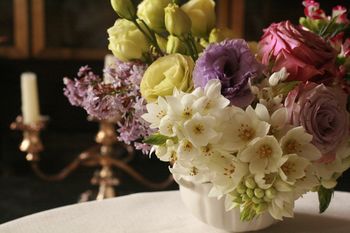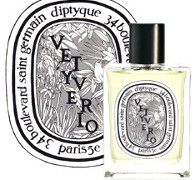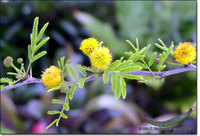I love reading old cookbooks. One is immediately immersed into another world, where the daily concerns, dietary beliefs and time constraints are very different from ours. The recipes reflect all of this, ranging from simple preparations to complex affairs requiring extra helping hands. Whether I open a 19th century book published in Russia or in France, I know that there is always something intriguing to anticipate, a new taste, a new technique, a new inspiration.
The main reason for my fascination with older cookbooks, however, lies in the explicit link between olfaction and cooking. Previous generations of cooks were quite savvy when it came to aromas, and they understood the basic principles of blending spices and herbs to create distinctive flavors. Recipes for perfumes were commonplace in cookbooks published before the 20th century, and those could be found alongside recipes for liqueurs and cordials. With the growth of the commercial perfume industry, the tradition of homemade fragrances waned and it is likely that many interesting preparations have simply been forgotten.
To illustrate my point, I have selected two recipes for floral liqueurs that straddle the line between a delicious beverage and a heady perfume. They are derived from the books I use frequently in my kitchen, and if you read French, I highly recommend both, especially since they are easily available through Kitchen Arts & Letters and Amazon. I am not going to compete with Rachel Ray here; for most of us without access to a blooming garden they are only curios. Nevertheless, imagine the jasmine’s fragrance of apricot jam and green banana in liqueur form. Or the voluptuous richness of Rosolies, a traditional Valencial liqueur made with roses and sweet spices.
Jasmine Ratafia (Ratafia de Jasmin)
The following recipe for ratafia, or cordial, comes from the 1910 edition of a wonderful book La Cuisinière Provençale, written by J.-B. Reboul. I present the recipe here as it was published in the book, but when I tried making it myself, I cooled the syrup to lukewarm before adding jasmine flowers. Instead of eau de vie, I used a high quality grappa, Italian brandy made from grape skins. Heavenly!
200g jasmine blossoms
1L eau-de-vie (marc, clear brandy)
Sugar syrup: 500g (1lb) sugar, 1L water
Prepare sugar syrup by adding sugar to water and simmering until sugar is dissolved. When it has been brought to boil, remove from the heat and add jasmine blossoms. Cover the pot and leave to infuse for 10min. Transfer to a wide mouth jar and add alcohol. Leave to infuse for 15 to 20 days. Filter, transfer to individual bottles and store in a dark, cool place.
Rose Liqueur (Rosolies, Liqueur de Roses de Valencia)
From La Cuisine Catalane by Eliane Thibaut Comelade, Tome II (Països Valencians, Baléars) published in 1979. Author specifies Valencia roses and Malaga raisins in her recipe, but any fragrant roses will work. Although the book is of a relatively recent vintage, the recipe is quite old.
2.5 L alcohol at 90% (clear grain alcohol, Everclear)
275g rose petals
26g jasmine blossoms
125g raisins
2 large pieces of mace
2.5g cinnamon bark
2.5g cloves
Syrup: 1kg (2lb) sugar, 1 L water
In a large jar, mix flowers, raisins, spices and alcohol. Let them macerate for 40 days.
After 40 days have passed, filter and add cold sugar syrup. Bottle and store in a dark, cool place.
To make sugar syrup, bring sugar and water to boil and simmer until the sugar is completely dissolved. Let it cool.
Photography © Bois de Jasmin.

















11 Comments
Katrina: So interesting. I may even try the Jasmine Ratafia recipe. July 19, 2011 at 8:40am
Suzanna: I have done something like the second recipe, but I added lemons. This resulted in a slightly fermented, lightly “fizzy” concoction that was quite pleasant when chilled.
It’s interesting how complex classic French and Russian cuisine is compared to, let’s say, British and American. The latter are not just more economical, they are often dowdy and devoid of spice to the point of having penetential overtones. Haute cuisine and Protestant work ethic are seemingly mutually exclusive. July 19, 2011 at 10:30am
Suzanna: Addendum: Great depth of field on the photo. July 19, 2011 at 10:31am
columbine: i’d love to try but i don’t know where to get fresh jasmin or roses that are safe for consumption… July 19, 2011 at 11:40am
Victoria: They are very interesting. Old books are filled with such unusual ideas. July 19, 2011 at 10:05am
Victoria: I have been reading Elizabeth David’s books on aromatics in English cookery, and it is quite fascinating. The older English cookbooks are likewise filled with many interesting combinations.
Rose and lemon makes for a great pairing. Actually, anything tart matches nicely with rose. I saw recipes for red currant jelly flavored with rosewater in my favorite 19th century Russian cookbook, “A Gift to Young Housewives” by Elena Molokhovets. The English translation is available, although the translator omitted 75% of the recipes! July 19, 2011 at 10:41am
Victoria: Thank you! I wished I had taken a photo of the ratafia, but the last time I made it was last summer. July 19, 2011 at 10:42am
Andy: I’d love to make something like the ratafia, it sounds delicious. I have one 3 foot trellis with three sambac jasmines growing up it (with a lot of training!) but I don’t think I’ll ever have enough fresh flowers to suffice since it only sends out a few new flowers a day. I love the details about the perfume recipes being put in cookbooks long ago! Being a soapmaker, I love blending my own fragrances for soap or personal use. Most recently, I created a beautiful tobacco leaf-ish accord by combining ylang ylang, west indies bay, petitgrain, patchouli, and cedarwood. I realize now what a shame it will be I ever lose the recipe I created, gone in the same way many of these old recipes have been. I am currently trying to make a soap fragrance based around a beautiful, herbaceous Hungarian lavender essential oil I have. With your expertise of raw materials, V, are there any things you can suggest which might be particularly nice to add? July 19, 2011 at 3:40pm
Victoria: Yes, wish they were easier to find… How I wish I had a garden!
Sent via BlackBerry from T-Mobile July 19, 2011 at 11:56am
Victoria: Andy, my jasmines go through several phases, it seems. Some years, they are completely covered with flowers. Others, I hardly get anything at all. They grow in pots. I have a small climbing jasmine, but it has not flowered yet.
Lavender is one of my favorite notes to work with, so I can imagine that you might be trying some interesting combinations. Have you ever tried it with with ambery notes like clary sage or labdanum? Tonka bean and lavender make for a great, elegant pairing (coumarin in tonka beans amplifies the natural coumarin in lavender.) Citrus like bergamot and mandarin work nicely. Of course, patchouli, oakmoss and vetiver are excellent with lavender. July 20, 2011 at 2:56pm
Andy: Thank you for the growing tips and blending advice! I now have an inspiration to try blending the lavender with ambery essential oils, whereas before I had only experimented with citrus and wood essences. July 22, 2011 at 8:17am